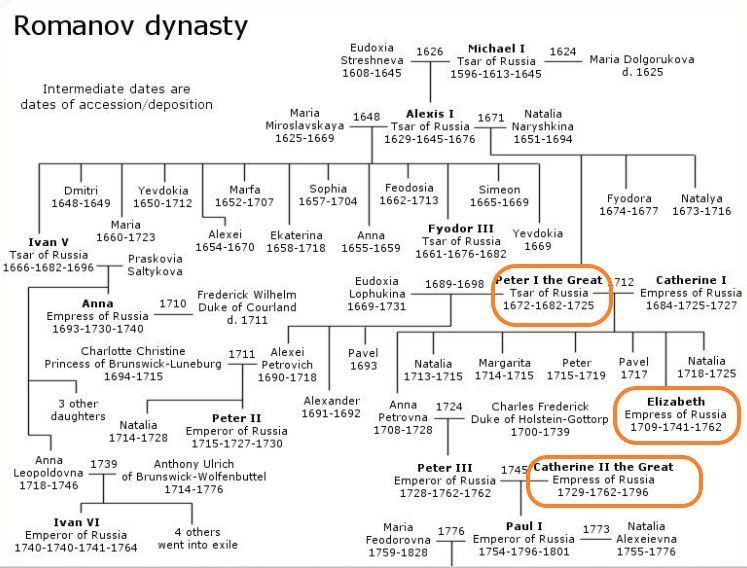Magnificent Mansions - Peterhof
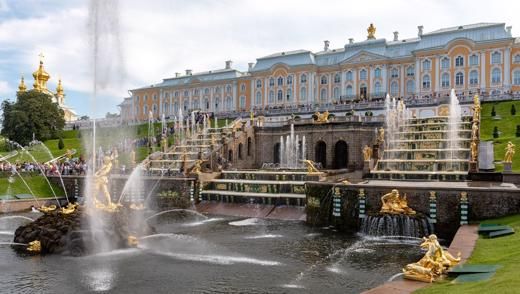
On the outskirts of St Petersburg a ring of former imperial residences are strung like the beads of an exquisite necklace. Peterhof is just one - and was the favourite residence of Peter the Great (known by the Russians as Peter I).
Peterhof is a set of palaces and gardens that until 1917 was home to the Tzars and known as the Russian Versailles and classifed as an UNESCO World Heritage site. Built in a grandiose C18th-C19th architectural style, the area covers 1000 hectacres, with over 30 buildings and pavillions, decorated with more than 100 sculptures.
In 2006 I had the pleasure of visiting Peterhof. Details below are taken from the guide book I purchased while there - Saint Petersburg and its Environs, as well as saint-petersburg.com, uleth.ca, russiau.com and courses.lumenlearning.com.
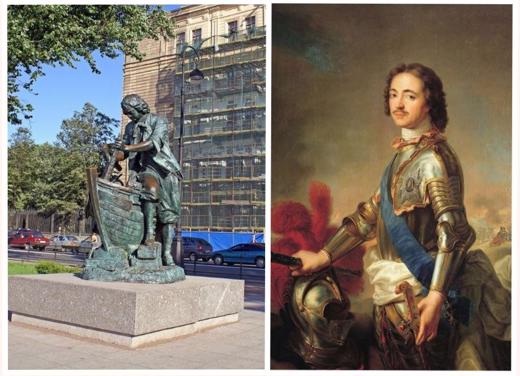
Peter the Great established Saint Petersburg in 1703. The city was built on the presumption that it would be the most westernized city of Russia. He moved the capital from Moscow to Saint Petersburg in 1712, when the city became the political and cultural centre of Russia.
Peter the Great was the 14th child of Alexei Mikhailovich, born on May 30, 1672, from his second marriage to Natalia Kirillovna Naryshkina. He ruled jointly with his brother Ivan V from 1682. Upon Ivan's death in 1696, Peter was officially declared Sovereign of all Russia.
Setting off to Europe in 1696 on the so-called Grand Embassy (a large Russian delegation whose purpose was to find allies for the war with Turkey), Peter travelled incognito under the pseudonym of Pyotr Mikhailov.
In Prussia, the Tsar studied artillery and received a certificate as a firearms master, and in Holland he learned the craft of shipbuilding by working at the bustling Dutch docks. In England he studied the latest advances in shipbuilding and industry.
As he travelled about Europe, Peter visited factories and libraries, listened to lectures at universities, and caroused with comrades; but this educational and entertaining voyage was cut short after 18 months by news of a Streltsy revolt 1 in Moscow. For the rest of his life, Peter the Great retained his love of knowledge, new technology, and of learned people, as is evidenced by his personal belongings, library and the interiors of his palaces.
Peterhof is dominated by the Grand Palace with its fabulous water gardens. As you can see from the map below, there are many other small buildings, museums or churches.
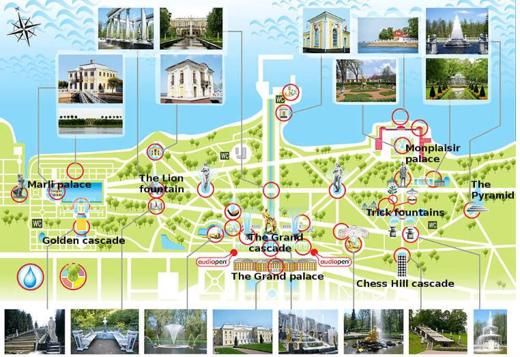
Versailles was the inspiration for Peter the Great's desire to build an imperial palace in the suburbs of his new city and, after an aborted attempt at Strelna where the land was too marshy, he sketched the inital design of the modest Monplaisir^ Palace, which became Peter's favourite summer retreat. Located by the sea, you can see why the State Hall (below) is considered cosy (by Royal standards anyway!)
^ Monplaisir translates to My Pleasure
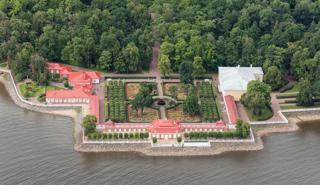
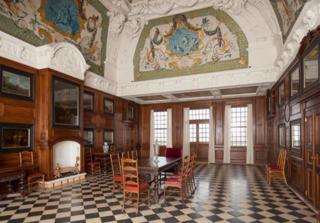
Later, Peter expanded his plans to include a vaster royal château of palaces and gardens further inland. On the model of Versailles Peterhof Grand Palace was built. Work halted after Peter's death in 1725, and Peterhof was almost abandoned until his daughter Elizabeth came to the throne in 1740 and commissioned Bartolomeo Rastrelli, who had already completed the Summer Palace in St. Petersburg, to build a genuinely regal palace, which is what we see today.
The long, narrow palace, which was built in the last decade before baroque made way for neoclassicism, has minimal decoration, and Rastrelli's chief stylistic flourishes are the two white pavilions with gilded cupolas at the end of the wings (as you can see below).
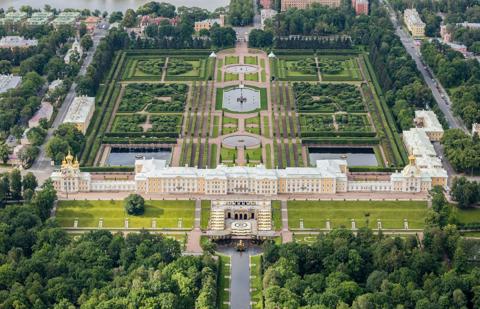
Inside, the Grand Palace is considerably more lavish, with interiors almost entirely reconstructed after WWII that represent a combination of original designs by Rastrelli with renovations by Yurii Felten and Vallin de la Mothe during the reign of Catherine the Great. Further changes were made in the mid-19th century, but nonetheless the palace's sumptuous interiors have retained a remarkable homogeneity of style. Let's take a look at some of the rooms.
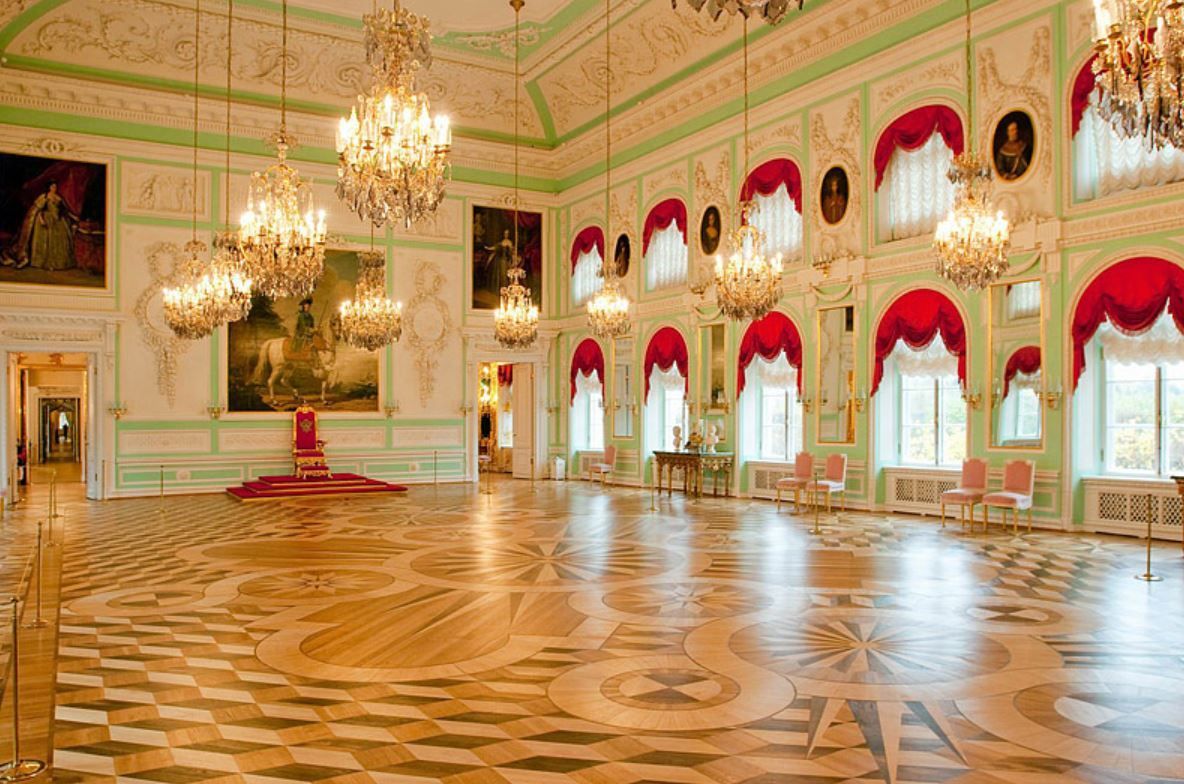
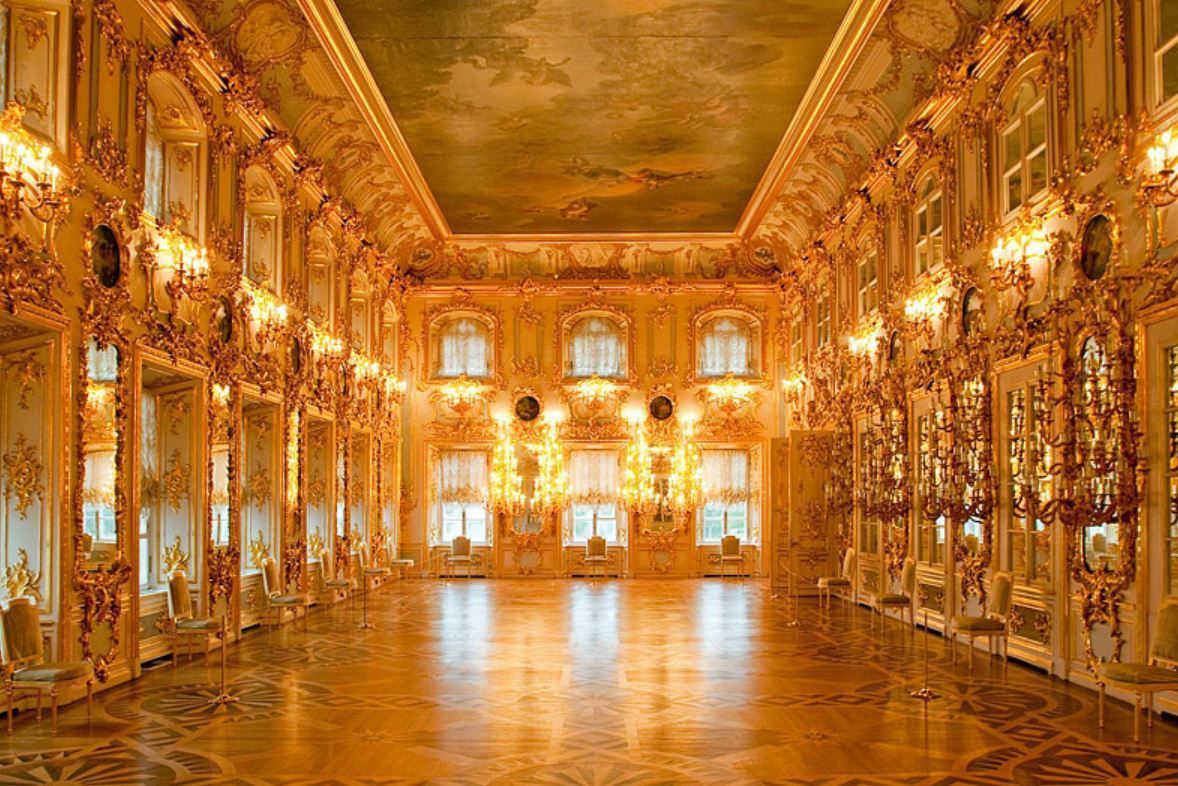
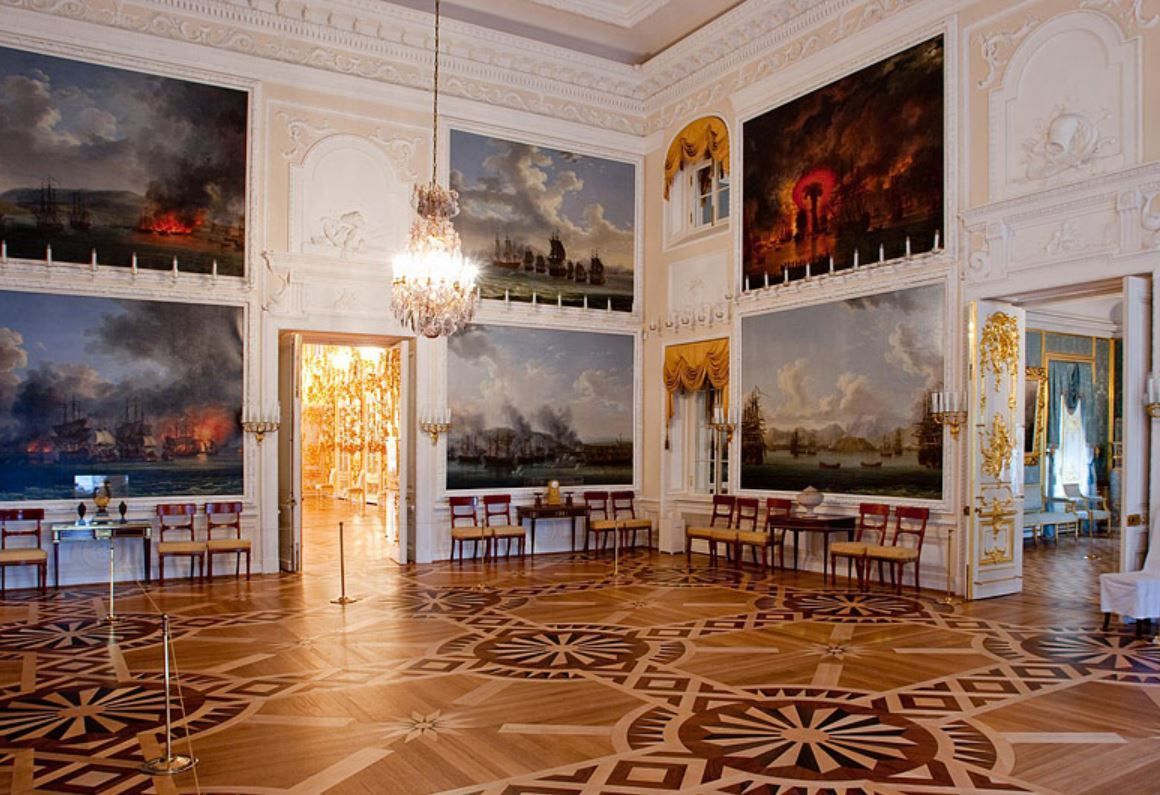
The largest stateroom is the Throne Room with an area of 300 meters, while a double row of windows in the Ballroom reflected in a series of mirrors, visually increases the size of the hall.
A large number of windows of different shapes and sizes interspersed with strategically placed windows were a common device used in Baroque architecture to create the illusion of endless space. Regulars may remember the same feature used at Versailles, Schonnbrun and Sanssouci.
The Chesma Hall is decorated with twelve large paintings of the Battle of Chesma, a stunning naval victory of the Russo-Turkish War, 1768-1774. These were painted between 1771 and 1773 by the German artist Jacob Philipp Hackert.
The palace is majestic and provides a perfect backdrop to the elegantly formal Upper Garden, the spectacular Grand Cascade and extensive parkland. A highlight of visiting Peterhof is dawdling through the gardens and admiring the many fountains, which you can experience by watching this short video.
I am sure you agree they are stunning, yet the Grand Cascade is just a small part of the Peterhof complex - to give you some context I have marked this on the aerial view below.
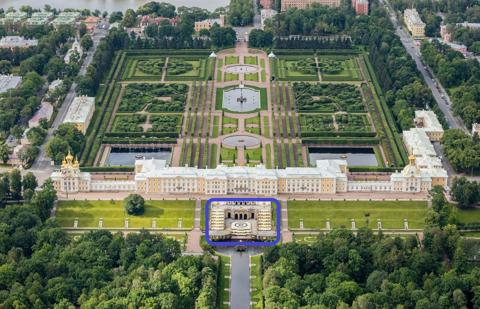
Now for a close look at some of the fountains and sculptures.
The centrepiece of the Grand Cascase is the fountain of Samson Tearing open the Jaws of the Lion, created in honour of the 25th anniversary of the famous Poltava Battle, representing Russia's victory over Sweden in the Great Northern War.
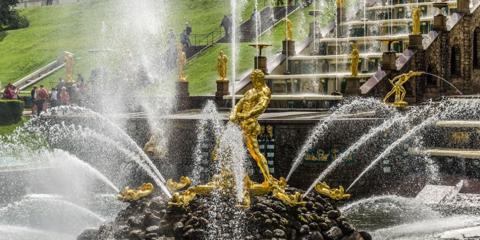
There are 150 fountains on the grounds of Peterhof. Fountains were intrinsic to Peter the Great's original plans for Peterhof - it was the impossibility of engineering sufficiently powerful jets of water that prompted him to move his attentions from the Strelna site to Peterhof - and subsequent generations competed with their predecessors to add grander and ever more ingenious water features to the parkland surrounding the Grand Palace.
Below are just a few examples.

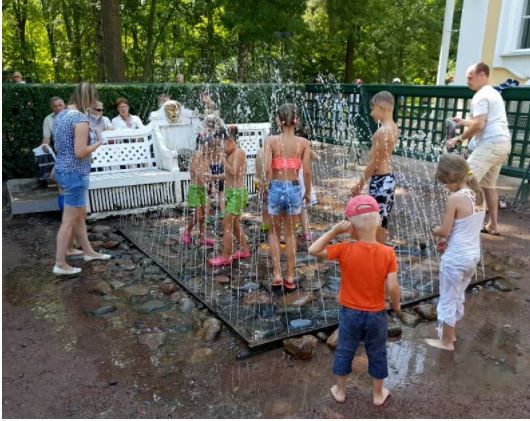

Peter the Great was the fourth Romanov ruler but the first Russian ruler to take the title of emperor; the first to travel widely at home and abroad and the first to be buried in St. Petersburg. He was both a reformer and a tyrant. He brought Russia into the modern age but to do so he relied on heavy-handed power and terror.
Despite his harsh rule, Peter undertook extensive reforms: he created a regular army and navy, subjugated the Church to the state and introduced new administrative and territorial divisions of the country. He paid particular attention to the development of science.
He was a far-sighted and skillful diplomat and a talented military leader.
Under Peter's rule, Russia became a great European nation. In 1721, he proclaimed Russia an Empire and was accorded the title of Emperor of All Russia.
Peter died from a chill on January 28, 1725, without nominating an heir, however his wife Catherine I reigned for 2 years until her death.
Their daughter Elizabeth lived under the confused successions of her father's descendants since her half-brother Alexei's death. The throne was first passed to her nephew Peter II, who died in 1730 and was succeeded by her first cousin Anna. After the brief rule of Anna's great-nephew, Ivan VI, Elizabeth seized the throne in 1741. We will tour Elizabeth's chief summer residence next week.
Here are a few more images of the fabulous gardens and fountains.
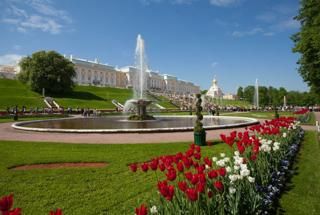
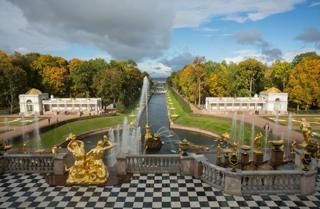
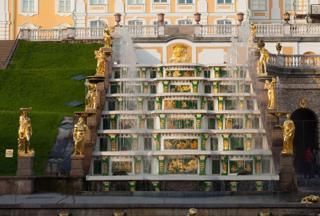
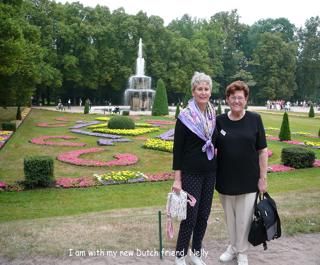
Next week we visit another palace on the outskirts of St Peterburg.
Footnotes
1 As depicted by Russian historians of the gentry-bourgeois school and by some Soviet historians, the strel’tsy uprising of 1698 was a reactionary rebellion against the progressive reforms of Peter I. In origin and in character, however, it was in fact more complex: an outburst against the increasingly burdensome yoke of serfdom, the hardships of state service, and oppression.
You can read more about it here:
https://encyclopedia2.thefreedictionary.com/Streltsy+Uprising+of+1698
2 Highlighted below are the Royal residents of the Romanov dynasty featured in this series of posts on the St Petersburg Mansions.
